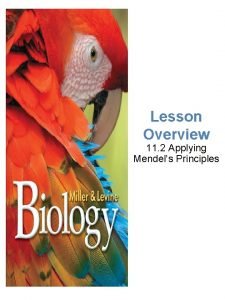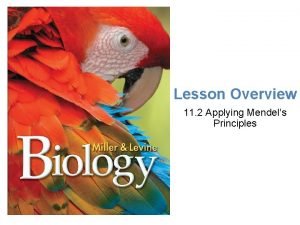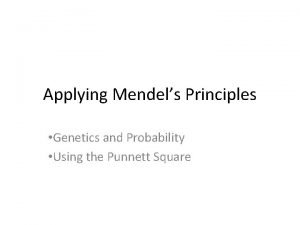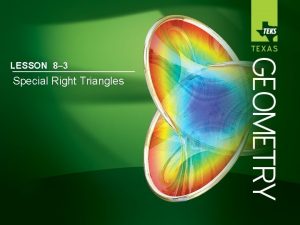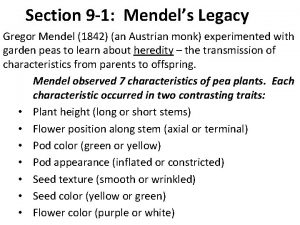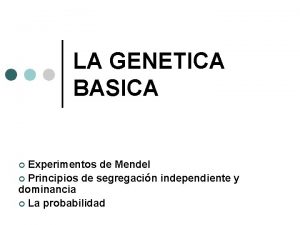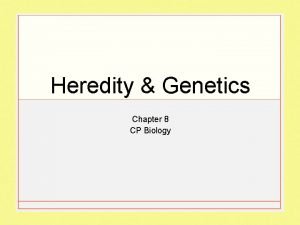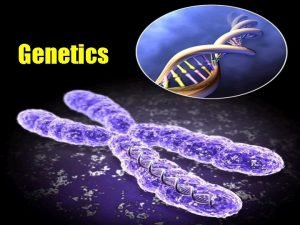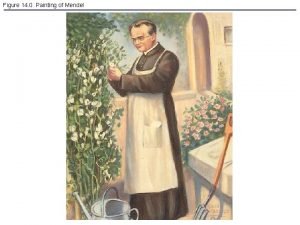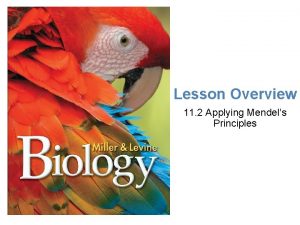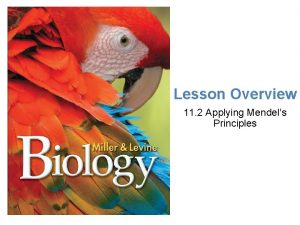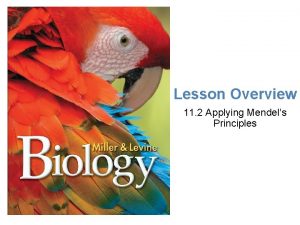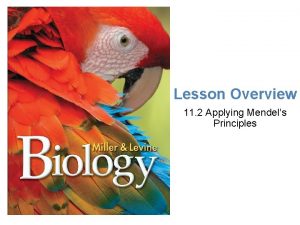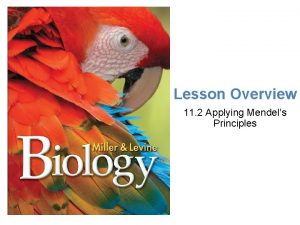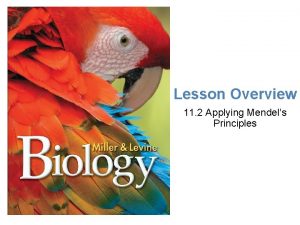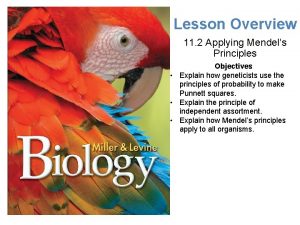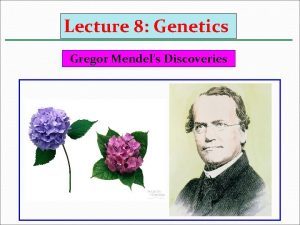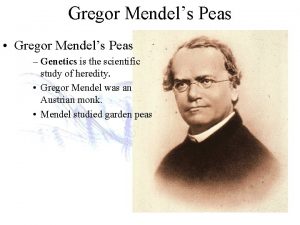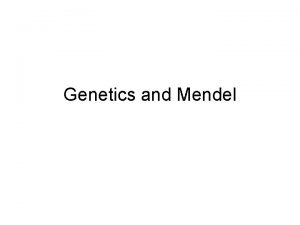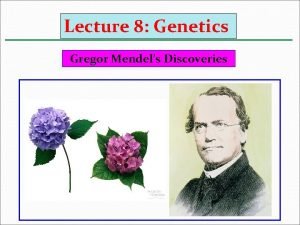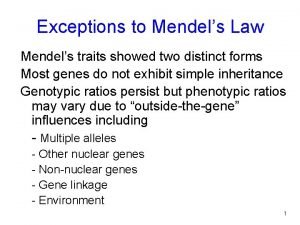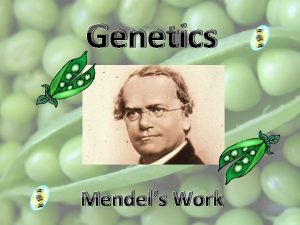Chapter 12 Lesson Overview 12 2 Applying Mendels



















- Slides: 19

Chapter 12 Lesson Overview 12. 2 Applying Mendel’s Principles

Lesson Overview Applying Mendel’s Principles Probability and Heredity • Mendel realized that the principles of probability could be used to explain the results of his genetic crosses. • Probability is the likelihood that a particular event will occur. • For example, there are two possible outcomes of a coin flip: The coin may land either heads up or tails up. • The chance, or probability, of either outcome is equal. Therefore, the probability that a single coin flip will land heads up is 1 chance in 2. This amounts to 1/2, or 50 percent. • If you flip a coin three times in a row, what is the probability that it will land heads up every time? • Each coin flip is an independent event, with a one chance in two probability of landing heads up. • Therefore, the probability of flipping three heads in a row is: 1/2 × 1/2 = 1/8

Lesson Overview Applying Mendel’s Principles Probability and Heredity • As you can see, you have 1 chance in 8 of flipping heads three times in a row. • Past outcomes do not affect future ones. Just because you’ve flipped 3 heads in a row does not mean that you’re more likely to have a coin land tails up on the next flip. Using Segregation to Predict Outcomes • The way in which alleles segregate during gamete formation is every bit as random as a coin flip. • Therefore, the principles of probability can be used to predict the outcomes of genetic crosses.

Lesson Overview Applying Mendel’s Principles Using Segregation to Predict Outcomes • Mendel’s cross produced a mixture of tall and short plants. • If each F 1 plant had one tall allele and one short allele (Tt), then 1/2 of the gametes they produced would carry the short allele (t).

Lesson Overview Applying Mendel’s Principles Using Segregation to Predict Outcomes • Because the t allele is recessive, the only way to produce a short (tt) plant is for two gametes carrying the t allele to combine.

Lesson Overview Applying Mendel’s Principles Using Segregation to Predict Outcomes • Roughly one fourth of the F 2 offspring should be short, and the remaining three fourths should be tall. • This predicted ratio— 3 dominant to 1 recessive— showed up consistently in Mendel’s experiments. • For each of his seven crosses, about 3/4 of the plants showed the trait controlled by the dominant allele. • About 1/4 of the plants showed the trait controlled by the recessive allele.

Lesson Overview Applying Mendel’s Principles Using Segregation to Predict Outcomes • Not all organisms with the same characteristics have the same combinations of alleles. • In the F 1 cross, both the TT and Tt allele combinations resulted in tall pea plants. The tt allele combination produced a short pea plant. • Organisms that have two identical alleles for a particular gene—TT or tt in this example— are said to be homozygous. • Organisms that have two different alleles for the same gene—such as Tt—are heterozygous.

Using Segregation to Predict Outcomes Probability of a gamete receiving a G? 50%, or 1/2 Probability of gamete receiving a g? 50%, or 1/2 Probability of green offspring is. 3/4 Probability of yellow offspring is. 1/4

Lesson Overview Applying Mendel’s Principles Genotype and Phenotype • Every organism has a genetic makeup as well as a set of observable characteristics. • All of the tall pea plants had the same phenotype, or physical traits. • They did not, however, have the same genotype, or genetic makeup. • There are three different genotypes among the F 2 plants: Tt, TT, and tt. • The genotype of an organism is inherited, whereas the phenotype is formed as a result of both the environment and the genotype. • Two organisms may have the same phenotype but different genotypes.

Lesson Overview Applying Mendel’s Principles How To Make a Punnett Square for a One-Factor Cross • Write the genotypes of the two organisms that will serve as parents in a cross. • In this example we will cross a male and female osprey that are heterozygous for large beaks. They each have genotypes of Bb. Bb and Bb

Lesson Overview Applying Mendel’s Principles How To Make a Punnett Square • Determine what alleles would be found in all of the possible gametes that each parent could produce. • Draw a table with enough spaces for each pair of gametes from each parent. • Enter the genotypes of the gametes produced by both parents on the top and left sides of the table.

Lesson Overview Applying Mendel’s Principles How To Make a Punnett Square • Fill in the table by combining the gametes’ genotypes. • Determine the genotypes and phenotypes of each offspring. • Calculate the percentage of each. In this example, three fourths of the chicks will have large beaks, but only one in two will be heterozygous.

Lesson Overview Applying Mendel’s Principles Independent Assortment • Mendel wondered if the segregation of one pair of alleles affects another pair. • Mendel performed an experiment that followed two different genes as they passed from one generation to the next. • Because it involves two different genes, Mendel’s experiment is known as a two-factor, or dihybrid, cross. Single-gene crosses are monohybrid crosses.

Lesson Overview Applying Mendel’s Principles The Two-Factor Cross: F 1 • Mendel crossed true-breeding plants that produced only round yellow peas with plants that produced wrinkled green peas. • The round yellow peas had the genotype RRYY, which is homozygous dominant. • The wrinkled green peas had the genotype rryy, which is homozygous recessive.

Lesson Overview Applying Mendel’s Principles The Two-Factor Cross: F 1 • All of the F 1 offspring produced round yellow peas. These results showed that the alleles for yellow and round peas are dominant over the alleles for green and wrinkled peas. • The Punnett square shows that the genotype of each F 1 offspring was Rr. Yy, heterozygous for both seed shape and seed color.

Lesson Overview Applying Mendel’s Principles The Two-Factor Cross: F 2 • Mendel then crossed the F 1 plants to produce F 2 offspring. • Mendel observed that 315 of the F 2 seeds were round and yellow, while another 32 seeds were wrinkled and green—the two parental phenotypes. • But 209 seeds had combinations of phenotypes, and therefore combinations of alleles, that were not found in either parent.

Lesson Overview Applying Mendel’s Principles The Two-Factor Cross: F 2 • The alleles for seed shape segregated independently of those for seed color. *Genes that segregate independently— such as the genes for seed shape and seed color in pea plants—do not influence each other’s inheritance. • Mendel had discovered the principle of independent assortment. The principle of independent assortment states that genes for different traits can segregate independently during gamete formation.

Lesson Overview Applying Mendel’s Principles A Summary of Mendel’s Principles • Where two or more forms (alleles) of the gene for a single trait exist, some forms of the gene may be dominant and others may be recessive.

Lesson Overview Applying Mendel’s Principles A Summary of Mendel’s Principles • In most sexually reproducing organisms, each adult has two copies of each gene—one from each parent. These genes segregate from each other when gametes are formed. • Alleles for different genes usually segregate independently of each other.
 Chapter 12 lesson 2 applying mendels principles
Chapter 12 lesson 2 applying mendels principles Applying mendel's principles
Applying mendel's principles 11.2 applying mendel's principles
11.2 applying mendel's principles Chapter 12 lesson 2 applying mendels principles
Chapter 12 lesson 2 applying mendels principles Applying mendels principles
Applying mendels principles Applying mendels principles
Applying mendels principles Chapter 9 lesson 2 photosynthesis an overview
Chapter 9 lesson 2 photosynthesis an overview Properties of similar triangles
Properties of similar triangles Lesson 5-8 applying special right triangles answer key
Lesson 5-8 applying special right triangles answer key 5-8 practice a applying special right triangles
5-8 practice a applying special right triangles 8-3 special right triangles answers
8-3 special right triangles answers Side side side similarity
Side side side similarity Section 9-1 review mendels legacy
Section 9-1 review mendels legacy Gregor mendel plant
Gregor mendel plant Segregación independiente de caracteres
Segregación independiente de caracteres Mendels law
Mendels law Law of segregation meiosis
Law of segregation meiosis Mendels law of segregation states that
Mendels law of segregation states that Mendel
Mendel Mendels two laws
Mendels two laws

